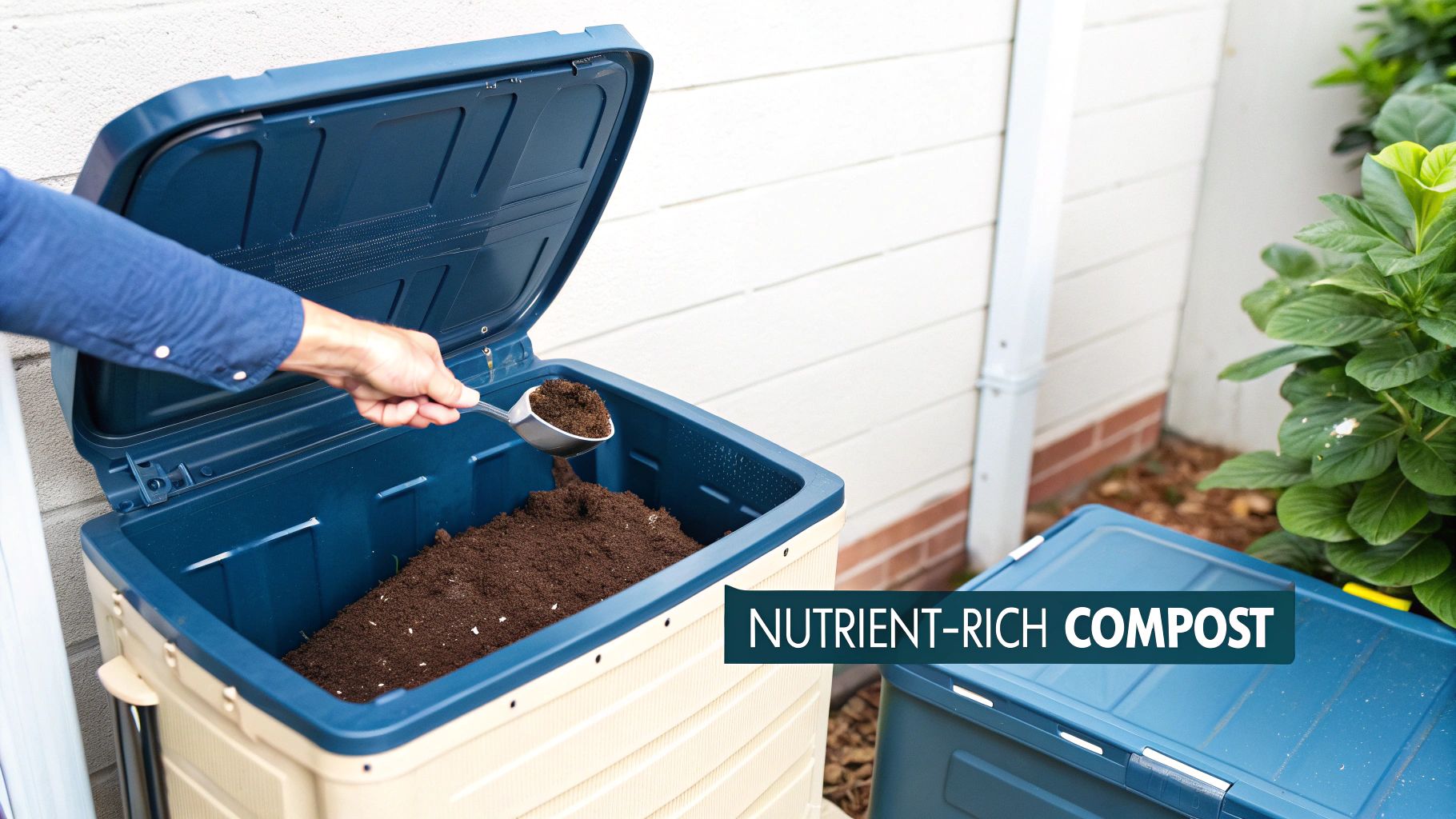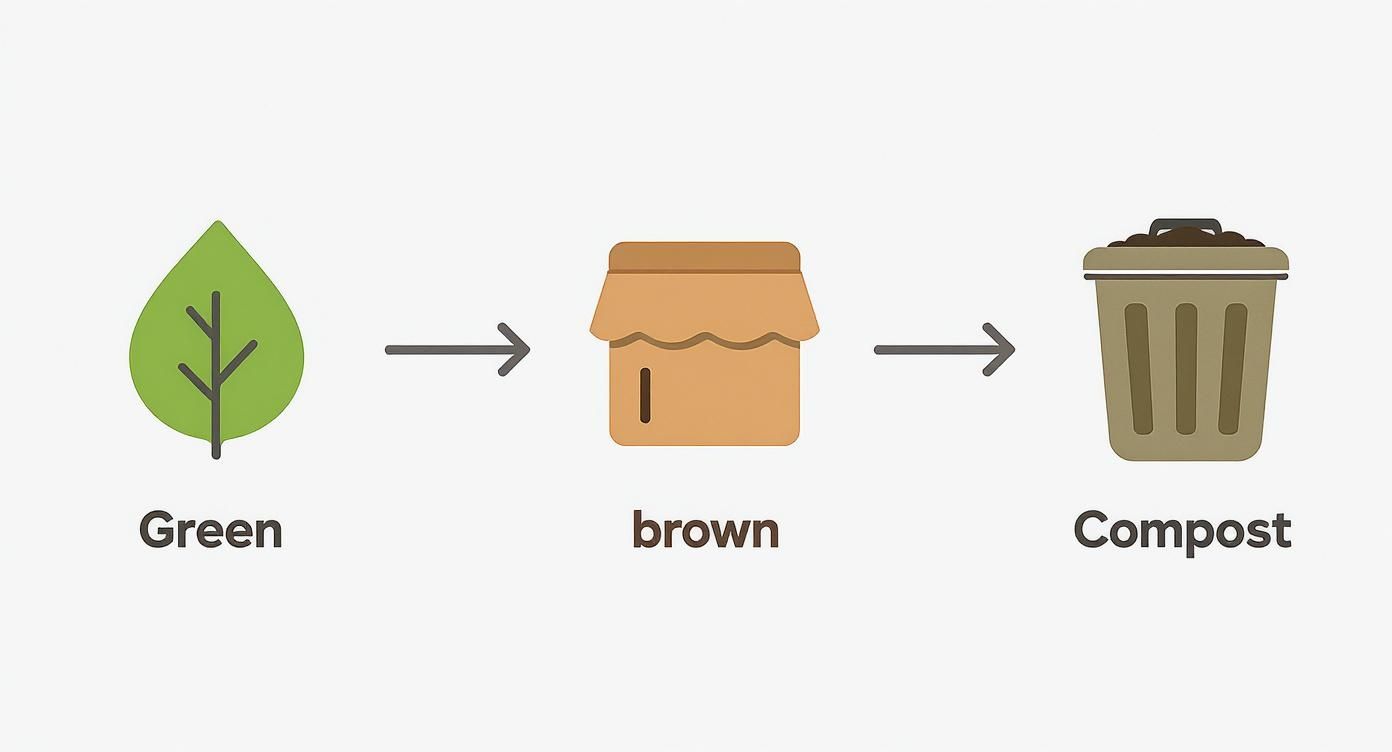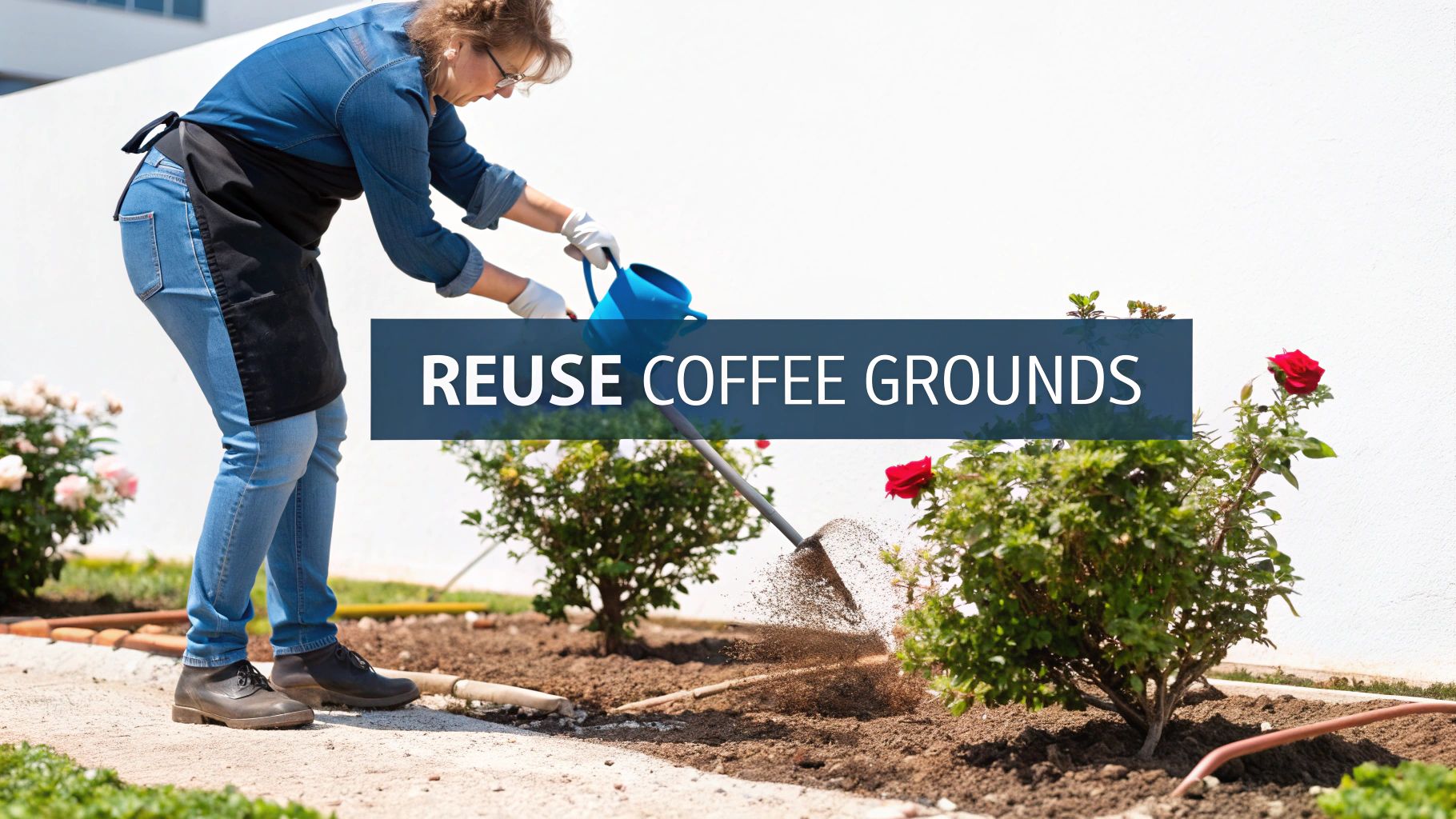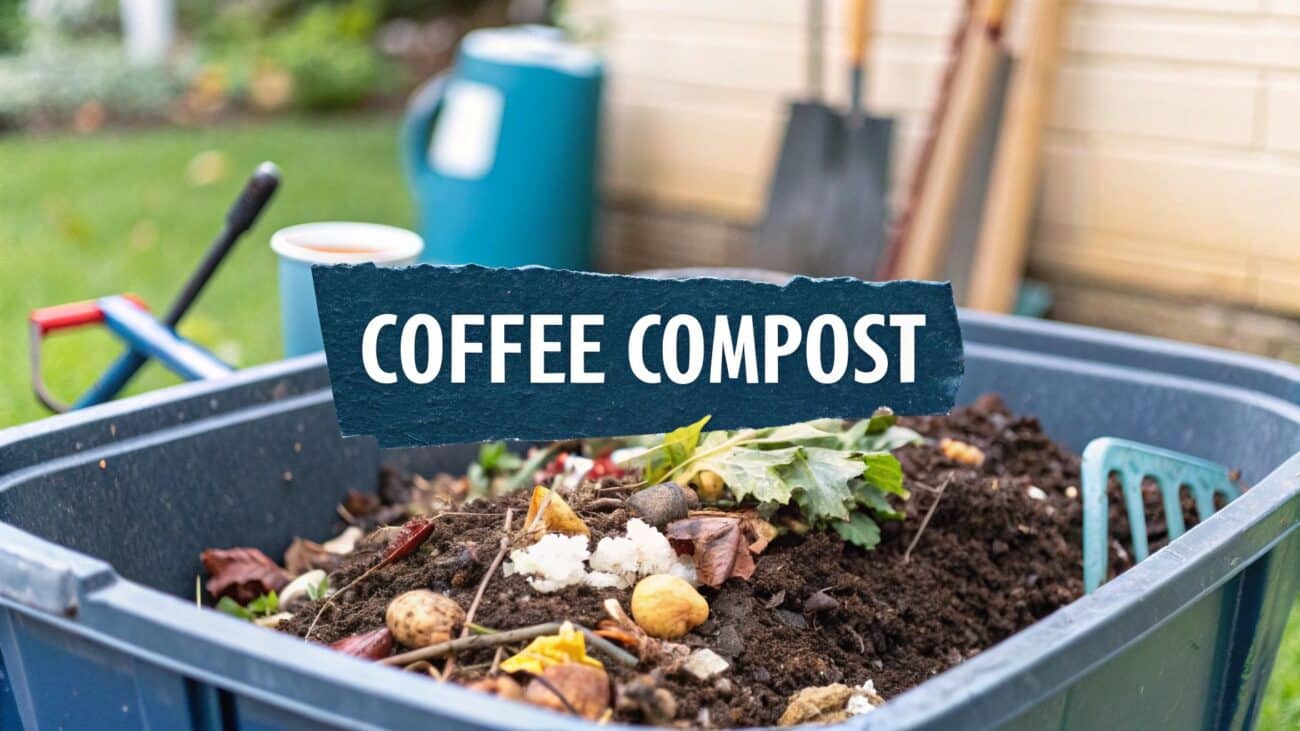Coffee grounds in compost bin: A guide to rich soil
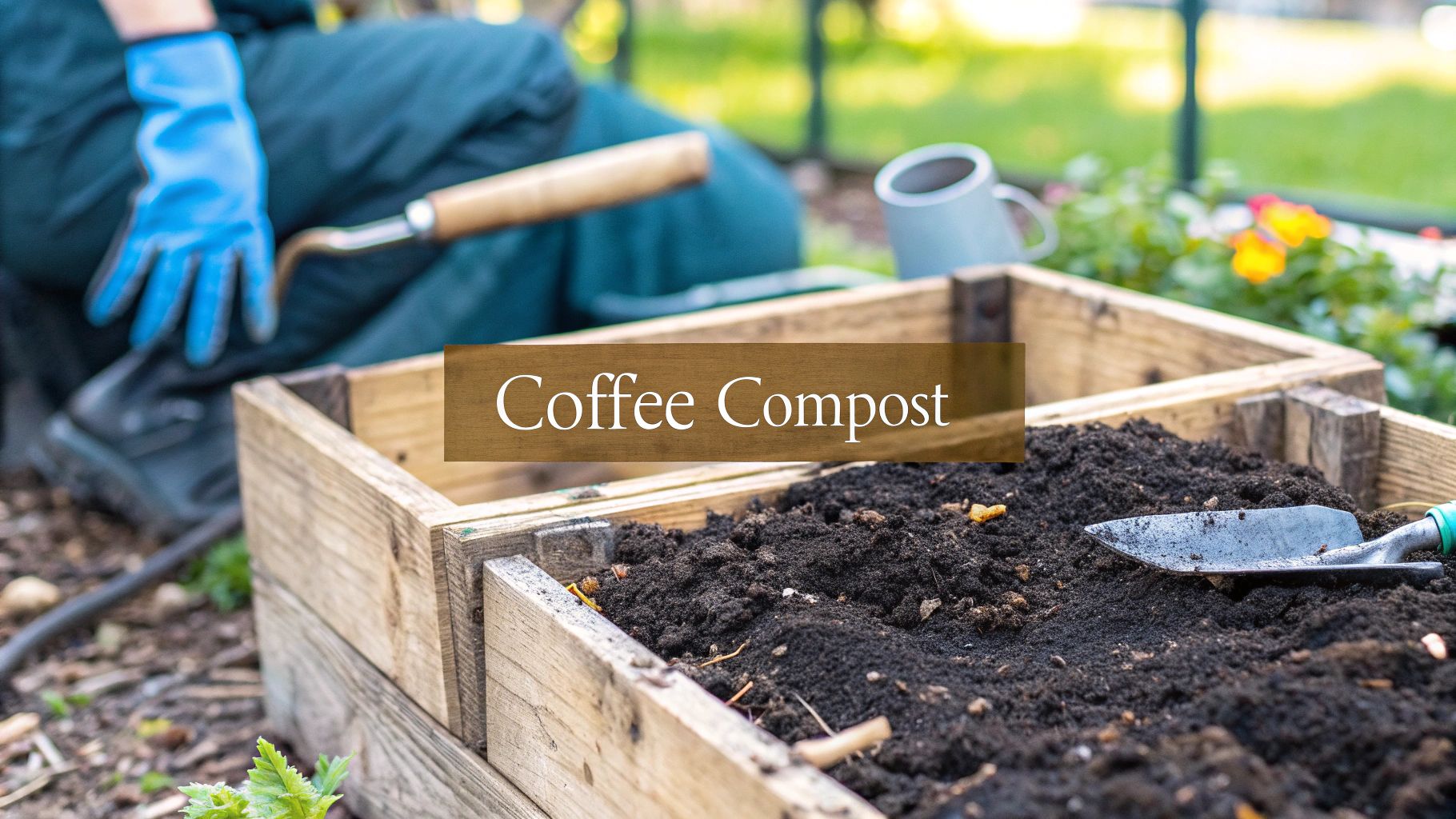
Yes, you can and absolutely should put coffee grounds in your compost bin. They are a brilliant source of nitrogen that gets things cooking, adding essential nutrients and improving your soil's structure. In short, they help turn kitchen waste into 'black gold' for the garden.
The Gardener's Secret to Nutrient-Rich Compost
That daily brew you enjoy could be the secret ingredient for creating incredible, nutrient-dense compost. For gardeners across the UK, adding used coffee grounds to the compost bin is a simple habit that transforms everyday kitchen scraps into a potent soil conditioner. It’s more than just a handy way to get rid of waste; it’s a genuine game-changer for your garden's health.
The real magic is what the grounds bring to the pile. Despite their dark brown colour, they’re classified as a 'green' material in composting terms. Why? Because they are packed with nitrogen, a critical element that fuels the microorganisms responsible for breaking down all that organic matter. Think of it as an accelerator for your compost, helping everything decompose faster and more efficiently.
Understanding the True Value of Your Coffee Grounds
Beyond just speeding things up, coffee grounds enrich the final compost with valuable nutrients. As they break down, they slowly release nitrogen, phosphorus, and potassium—all essential for robust plant growth. This process creates a well-rounded, natural fertiliser that improves soil structure, helps retain moisture, and encourages healthy root development.
There's a massive environmental benefit to think about, too. In the UK, we get through around 98 million cups of coffee every single day. That adds up to a staggering 35 billion cups a year, generating hundreds of thousands of tonnes of used grounds that often end up in landfill. By diverting this valuable stuff into your compost, you’re actively cutting down on methane emissions and making your household that little bit more sustainable.
The secret to great composting isn't about fancy equipment; it's about understanding the value of what you're adding. Coffee grounds are a prime example of a 'waste' product that holds immense potential for creating a thriving garden.
Before you toss another scoop of used grounds, let's break down exactly what they're bringing to your compost pile. This quick table summarises the key benefits.
Composting Coffee Grounds At a Glance
| Aspect | Detail | Why It Matters for Your Garden |
|---|---|---|
| Nutrient Content | Rich in nitrogen, plus phosphorus & potassium. | Acts as a natural, slow-release fertiliser that fuels healthy plant growth. |
| Material Type | Considered a 'Green' material. | Provides the essential nitrogen to balance 'browns' like leaves and cardboard. |
| Decomposition | Accelerates the composting process. | Feeds the beneficial microbes, helping your pile break down much faster. |
| Soil Structure | Fine, gritty texture. | Improves soil aeration and water drainage, preventing it from becoming compacted. |
| Waste Reduction | Diverts coffee grounds from landfill. | Reduces household waste and lowers your carbon footprint significantly. |
As you can see, every scoop contributes something meaningful. It's a simple, effective way to turn a daily habit into a direct benefit for your garden's ecosystem.
Why Your Garden Will Thank You
The benefits of incorporating coffee grounds into your composting routine are real and impactful. You’re not just getting rid of waste; you're creating a closed-loop system where your kitchen directly nourishes your garden.
Here’s a quick breakdown of the main advantages:
- Nutrient Boost: They slowly release essential minerals into your compost, creating a rich feed for your plants.
- Improved Soil Structure: The fine texture of the grounds helps to improve soil aeration and drainage, preventing compaction.
- Microorganism Fuel: The high nitrogen content provides the energy needed for beneficial bacteria and fungi to thrive and break down organic matter.
- Waste Reduction: It’s an easy and effective way to reduce your household's contribution to landfill, turning a waste product into a valuable asset.
Ultimately, composting coffee grounds is a cornerstone of responsible gardening. It’s a simple step that makes your garden more productive and your lifestyle more sustainable. For a broader look at managing garden waste, including more than just coffee grounds, it's worth exploring different methods for disposing of garden waste. This holistic approach ensures every piece of organic matter is put to its best use. To see how grounds benefit plants directly, check out our guide on https://sevensisterscoffee.co.uk/is-coffee-grounds-good-for-plants/.
Getting the Green and Brown Compost Ratio Just Right
A thriving compost pile is a living, breathing ecosystem, and just like any ecosystem, it all comes down to balance. The real secret to getting fast, sweet-smelling compost lies in understanding the relationship between two key ingredients: ‘greens’ and ‘browns’. This isn't about colour, but chemistry—specifically, the Carbon-to-Nitrogen (C:N) ratio.
Think of it like building a fire. The ‘browns’ are your logs—carbon-rich materials that provide the slow-burning fuel. Your ‘greens’ are the nitrogen-rich kindling that gets everything going. You need both, in the right amounts, to create a hot, efficient burn.
This is where a common myth about coffee grounds trips people up. Because they’re dark brown, gardeners often toss them in the pile thinking they’re a carbon source. But in the world of compost, used coffee grounds are a powerful 'green' material.
Why Coffee Grounds Count as a 'Green'
When we talk about 'greens' and 'browns', we're really talking about the main element each material brings to the party.
- Greens (Nitrogen-Rich): These are the activators. They provide the protein and moisture that microorganisms need to multiply and get to work, heating up the pile.
- Browns (Carbon-Rich): These are the fuel. They provide the energy source for the microbes and add bulk and structure, creating vital air pockets that stop the pile from turning into a dense sludge.
Used coffee grounds have a Carbon-to-Nitrogen ratio of about 20:1, which plants them firmly in the nitrogen-rich 'green' camp. They’re a fantastic kick-starter for your compost, fuelling the microbial rave that breaks everything down into that beautiful, crumbly 'black gold'.
The main thing to remember is simple: treat your coffee grounds as a potent green ingredient. Don't let their colour fool you. Their real superpower is their high nitrogen content, which is key to firing up the whole composting process.
Building Your Perfect Compost Lasagne
Striking the perfect balance in your coffee grounds in compost bin is all about layering. You don't need a degree in chemistry, just a solid rule of thumb. A good target is to aim for roughly two to three parts 'browns' for every one part 'greens' by volume.
Here are some typical examples of 'greens' and 'browns' you'll find around a UK home and garden to mix with your coffee grounds.
Common 'Green' (Nitrogen) Materials:
- Used Coffee Grounds & Tea Bags: Your daily brew is a steady and reliable source of nitrogen.
- Fruit & Vegetable Scraps: Peelings, cores, and kitchen offcuts are composting gold.
- Fresh Grass Clippings: A very powerful activator, but add it in thin layers to stop it from forming slimy, matted clumps.
- Plant Cuttings & Weeds: As long as they haven't gone to seed, they're a great addition.
Common 'Brown' (Carbon) Materials:
- Cardboard & Paper: Shredded toilet roll tubes, egg cartons, and non-glossy newspaper are perfect for adding structure.
- Fallen Leaves: An autumn bounty that provides the essential carbon your pile craves.
- Twigs & Wood Chippings: These break down slowly, creating brilliant air pockets. The fineness of these materials matters, much like how different settings impact your coffee maker; you can explore more about how the size of particles affects processes by looking into a coffee grind size guide.
- Straw or Hay: Ideal for adding bulk and preventing the pile from getting too wet.
Let's put it into practice. Imagine you've just emptied your kitchen caddy, which is full of coffee grounds and veg peelings (your 'greens'). To balance that out, you’d add a much larger layer of shredded cardboard and a good handful of dry leaves (your 'browns') on top. This layering technique, just like making a lasagne, ensures a good mix of air, moisture, fuel, and activators throughout your bin. It's this balance that stops a compost pile from becoming a smelly, sludgy mess and turns it into an efficient, earthy-smelling recycling machine.
How to Properly Add Coffee Grounds to Your Bin
Knowing that coffee grounds are a nitrogen-rich 'green' is a great start, but how you add them to your bin is just as important. Getting this part right is often the difference between a thriving compost ecosystem and a slow, sludgy mess. It’s all about creating the perfect conditions for those helpful microbes to get to work.
The biggest mistake I see people make is creating dense, compacted layers. If you just dump a week's worth of coffee grounds on top of your pile, it can form a thick, water-resistant cap. This barrier blocks air and moisture from circulating, effectively suffocating the beneficial organisms underneath and grinding decomposition to a halt.
Collecting and Storing Your Grounds
First things first, you’ll need a simple system for gathering your grounds. A small caddy on the kitchen counter is perfect for daily collection. Don't worry about the small amount of moisture left in them; it's actually beneficial for the compost.
If you find you’re not generating enough grounds at home, don't be shy about asking your local coffee shop. Many independent cafés are more than happy to give their used grounds to gardeners. They often see it as a positive way to reduce their own waste, so it's a win-win for everyone.
A quick tip if you're storing grounds for more than a couple of days: watch out for mould. If you've collected a big bag from a café, spread the grounds thinly on a tray or some old newspaper for a few hours. Letting them air out slightly before adding them to your main bin reduces the chance of unwanted fungal growth.
The Best Techniques for Adding Grounds to Your Compost
Once you've got your grounds, resist the urge to just tip them in. The best practice is to always mix them with a generous amount of 'brown' materials. This ensures your coffee grounds in compost bin contribute to a balanced, aerated environment, not a dense, wet one.
Here are a few practical methods I've found work wonders:
- Mix Before You Add: The ideal approach is to have a pile of 'browns' (like shredded cardboard or dry leaves) handy. Mix your wet coffee grounds and other kitchen scraps into the browns first, then add the combined mixture to your main bin.
- Thin Layers: If you're adding grounds daily, just sprinkle them in a thin, even layer across the surface of your compost. The key is to immediately cover this with a thicker layer of brown material.
- Pocket Composting: Grab a garden fork and dig a small hole or 'pocket' in the centre of your compost pile. Pour your coffee grounds and other green materials inside, then cover it back up thoroughly with the surrounding compost.
This infographic neatly shows how these green and brown elements work together to create the perfect compost balance.
As the visual highlights, a successful compost pile relies on integrating—not just layering—these different materials to maintain airflow and keep those microbes happy.
Don't Forget Your Paper Coffee Filters
Here’s a fantastic bonus that many people overlook: your paper coffee filters can go straight into the compost bin with the grounds. In fact, they are a brilliant addition.
Unbleached paper filters are a pure carbon source, making them a 'brown' material. This means they perfectly complement the nitrogen-rich 'green' grounds they hold. Including the filter helps to improve the all-important C:N ratio of your pile every time you add your coffee waste. For those who enjoy different brewing methods, understanding the materials involved can be part of the fun; you can learn more about the specifics of a popular method in this guide to pour-over coffee with a V60.
To help them break down faster, I always tear the filter and grounds into a few smaller pieces before tossing them in. This simple habit adds valuable carbon and helps create better structure within the compost, preventing compaction and improving aeration. It’s a small action that makes a big difference to your composting efforts.
Troubleshooting Common Composting Problems
Even the most seasoned composter runs into trouble now and then. A pile that suddenly smells funky, gets a bit too soggy, or attracts some unwelcome visitors can feel like a failure, but don’t worry. These are common hiccups, and they’re almost always a quick fix.
Think of these issues as your compost pile sending you a signal. It’s just telling you that its delicate ecosystem needs a small adjustment. When you add a powerhouse ingredient like coffee grounds, it gets things cooking, but you have to keep the balance right.
Why Is My Compost Too Wet or Slimy
A soggy, slimy compost pile is probably the most frequent issue people face. It’s a classic sign that you’ve got too many ‘green’ materials—like your coffee grounds and kitchen scraps—and not enough ‘browns’ to balance them out.
Coffee grounds are quite fine and can easily compact, creating dense, airless layers that trap moisture. When this happens, decomposition slows down, and things start to get smelly and slimy.
The solution is simple: you need more carbon.
- Shredded Cardboard or Paper: These are brilliant for soaking up excess moisture and creating little air pockets.
- Dry Autumn Leaves: A fantastic, free source of carbon that adds much-needed bulk.
- Small Twigs or Wood Chippings: Perfect for creating larger air channels to improve aeration throughout the pile.
Grab a garden fork and give the pile a good turn as you mix in these new materials. Your goal is to break up any slimy clumps and get oxygen flowing again. This helps the good aerobic bacteria get back to work and prevents the pile from producing methane, a potent greenhouse gas.
Dealing with Unwanted Pests
Finding flies, rats, or other critters in your compost bin is enough to put anyone off. The good news is that this problem is almost always caused by exposed food scraps, not the coffee grounds themselves.
A well-managed, active pile is your best defence.
The most effective pest deterrent is a well-managed, active compost pile. Burying fresh kitchen scraps deep within the centre of the pile ensures they are covered by older material, masking smells and making them inaccessible.
Make it a habit to cover any new additions of kitchen scraps with a generous layer of ‘browns’ like leaves or shredded paper. This simple step creates a physical barrier and helps neutralise the odours that attract pests in the first place. A secure lid is also a must-have.
The core principles of managing organic matter apply here, whether it’s coffee grounds or other materials. For more on composting challenging materials safely, this resource offers some great transferable advice.
Are My Coffee Grounds Making My Compost Too Acidic
There’s a stubborn myth floating around that coffee grounds will make your compost—and eventually your soil—far too acidic. While fresh coffee itself is acidic, the brewing process washes most of that away.
Used coffee grounds have a pH that’s surprisingly close to neutral, typically ranging from 6.5 to 6.8. That’s a perfect range for most garden plants.
In reality, the small amount of grounds you add to a large compost pile gets buffered by all the other ingredients. It will have a negligible effect on the final pH. So, unless you’re dumping truly massive quantities into a tiny bin, you have nothing to worry about.
By the way, if you’re a fan of smoother coffee, our guide on how to make cold brew coffee is worth a read—the gentler brewing method also affects the final composition of the grounds.
Common Composting Problems and Solutions
To help you diagnose any issues at a glance, here’s a quick reference table for some of the most common problems you might encounter when composting with coffee grounds.
| Problem | Likely Cause | How to Fix It |
|---|---|---|
| Pile has a strong, ammonia-like smell | Too many 'green' materials (high nitrogen). | Add more 'brown' materials like dry leaves, straw, or shredded cardboard. Turn the pile to aerate. |
| Compost is dry and not breaking down | Not enough moisture or 'green' materials. | Lightly water the pile and mix in more 'greens' like kitchen scraps or fresh coffee grounds. |
| The centre of the pile is cold | Pile is too small, too dry, or lacks nitrogen. | Add more material to increase its size. Add water if dry and mix in 'greens' to kickstart heating. |
| It’s attracting lots of fruit flies | Exposed fruit and vegetable scraps. | Bury fresh scraps deep within the pile and cover them with a layer of 'browns' or finished compost. |
Think of this table as your go-to cheat sheet. With a bit of practice, you’ll be able to read the signs and keep your compost thriving.
Using Coffee Grounds Beyond the Compost Bin
While the compost bin is an excellent home for your used coffee grounds, their value doesn't stop there. This fantastic resource from your kitchen can be used directly in your garden in several powerful ways, helping you build a truly closed-loop system where nothing goes to waste.
Thinking beyond the bin means you can apply the benefits of coffee grounds immediately, without waiting for your compost to mature. It's a way of giving your garden a direct boost, using a 'waste' product to solve common gardening challenges and improve overall soil health.
As a Slow-Release Fertiliser
One of the most effective direct uses for coffee grounds is as a slow-release fertiliser. Just as they provide that nitrogen kick for your compost pile, they can do the same for your soil, gradually releasing nutrients as they decompose.
This makes them particularly brilliant for plants that crave nitrogen to produce lush, vibrant foliage.
- Roses and Azaleas: These flowering shrubs benefit from the gentle, steady supply of nutrients.
- Leafy Greens: Vegetables like spinach, kale, and lettuce will appreciate the nitrogen boost for healthy leaf growth.
- Root Vegetables: Carrots and radishes also respond well to the soil enrichment provided by the grounds.
To use them, simply sprinkle a thin layer of used grounds around the base of your plants and gently work it into the top inch of soil. A word of caution: don't apply a thick, dense layer. It can form a crust and actually block water from reaching the roots.
Improving Heavy Clay Soil
If you battle with heavy, compacted clay soil in your garden, coffee grounds can be a genuine game-changer. Their fine, gritty texture helps to break up dense clay particles, improving both the structure and aeration of the soil over time.
When you work coffee grounds into clay soil, you're creating thousands of tiny air pockets. This process allows water to drain more effectively and makes it much easier for plant roots to penetrate the soil and access the nutrients they need to thrive.
Using coffee grounds directly in your garden isn't just about feeding plants; it's about fundamentally improving the soil they live in. By enhancing aeration and structure, you're creating a healthier foundation for your entire garden.
A Natural Pest Deterrent
Many gardeners swear by coffee grounds as a natural and surprisingly effective deterrent for some of the garden's most notorious pests. While it's not a guaranteed fix for every problem, it’s a simple, non-toxic method that’s well worth trying.
Slugs and snails, in particular, are said to dislike the abrasive texture of the grounds. Creating a ring of dry coffee grounds around vulnerable plants like hostas or young seedlings can form a barrier that these slimy pests are reluctant to cross. The lingering coffee scent may also help to confuse and repel other unwanted visitors.
This sustainable approach has gained real traction, reflecting a broader movement towards innovative recycling. In the UK, for instance, the recycling of coffee grounds has led to pioneering solutions, with companies like Bio-Bean transforming coffee waste into biofuels and coffee logs. To get the full scope, you can read the evaluation report on coffee ground recycling.
Exploring different uses for everyday items is at the heart of creative gardening and coffee enjoyment alike. For more interesting reads and brewing tips, you can explore the articles on our Seven Sisters Coffee blog.
Got Questions? We’ve Got Answers
Even when you know the basics, a few specific questions always seem to crop up. Getting a straight answer to these common composting queries will give you the confidence to get the best out of your coffee grounds. Let's tackle the ones we hear the most.
Is It Possible to Add Too Many Coffee Grounds to My Compost?
Yes, you can definitely have too much of a good thing. While coffee grounds are a fantastic compost ingredient, balance is the name of the game.
If your grounds start to dominate the pile, they can compact into a dense, sludgy layer that chokes off airflow. This leads to slow, smelly anaerobic decomposition—the kind that produces that unpleasant whiff of ammonia. A good rule of thumb is to keep coffee grounds to no more than 20-25% of your compost's total volume. The real trick is to always mix them in with plenty of 'browns' like dry leaves or shredded cardboard to keep things light and airy.
Aren't Coffee Grounds Too Acidic for a Healthy Compost Pile?
This is probably the most persistent myth in the world of gardening. While a fresh, unbrewed coffee bean is acidic, the brewing process neutralises the grounds almost completely. The acid ends up where you want it: in your morning cup.
Used coffee grounds have a pH level that’s pretty much neutral, typically landing somewhere between 6.5 and 6.8. This is a perfect range for your compost and won’t throw your garden soil out of whack. So, you can add them without a second thought—they won’t cause any acidity problems for the vast majority of plants.
That whole "coffee grounds are too acidic" thing? It's a classic composting myth. Used grounds are near-neutral and won't mess with your compost's pH. The other materials in your pile will easily buffer any tiny fluctuations.
Do I Need to Dry My Coffee Grounds Before Composting?
There’s absolutely no need to dry your grounds before they go into your main outdoor compost bin. In fact, you don't want to!
The moisture they hold is a bonus, helping the microorganisms thrive and get on with the job of breaking everything down. A healthy compost pile should feel like a wrung-out sponge, and the damp grounds help maintain that ideal environment.
The only time you might think about drying them is if you're collecting a big batch in a kitchen caddy for a few days. Spreading them on a tray can prevent a bit of surface mould, but it’s not an essential step for the compost itself.
Can the Paper Coffee Filter Go in the Compost Too?
Absolutely! You shouldn't just compost the filter—you really should. Paper filters are a brilliant addition to your pile.
Made from wood pulp, they count as a carbon-rich 'brown' material. This means they perfectly balance the nitrogen-rich 'green' coffee grounds inside them. It's a ready-made C:N ratio helper.
- Balances Your Pile: Tossing in the filter with the grounds helps maintain that critical carbon-to-nitrogen balance.
- Adds Air Pockets: The paper provides a bit of structure, helping to keep your compost from becoming too dense.
- Decomposes Easily: For a slightly faster breakdown, just rip the filter and grounds into a few pieces before you throw it in.
Making this a habit means you’re recycling the whole package and getting better compost in the process.
At Seven Sisters Coffee Co, we believe a great cup of coffee should be a sustainable pleasure, right down to the last ground. By turning your daily brew into garden gold, you're completing a beautiful cycle of flavour and growth. Discover our exceptional, artisan-roasted coffees and make every cup count by visiting us at https://sevensisterscoffee.co.uk.

